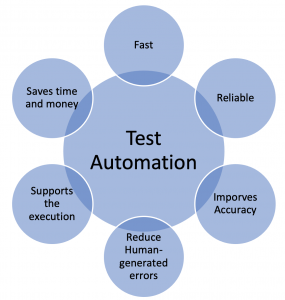Test automation: Getting more control and business value
During the crisis, many companies created ad hoc online services to help their employees and customers. These services were available to the public within a few weeks. However, we know that the more pressure that a company is put on, the more likely they are to make mistakes. Online services can suffer from various factors, such as the lack of trust in their applications and the end-user’s dissatisfaction. In the long run, this can lead to lost sales and customers, not to mention the company’s reputation. This is why it is important that companies have the proper quality assurance (QA) procedures in plac, before, during and after the digital initiatives. One of the most important factors that the crisis highlighted was the need for continuous testing.
Today, the majority of businesses use agile development approaches and DevOps practices, often with at least daily builds. On the other hand, testing is still mostly done manually, which slows down the quick deployment of software. Because conventional testing cycles usually last weeks and can no longer keep up with the ever-shorter release frequencies that digitization brings with it. But development and DevOps teams need continuous feedback throughout the release and digitization cycle to ensure the quality of their work. Doing this with manual tests is simply impossible. However, when organizations don’t continually review how the latest code changes impact critical end-to-end transactions and the user experience suffers. To solve the dilemma, test processes must also become agile and integrate seamlessly into the continuous delivery pipeline. A development towards continuous testing becomes indispensable. Test automation delivers value when it is performed frequently. But it is precisely then that it must be robust in order to deliver reliable results. This method can help companies deliver new applications faster and improve their overall performance.

Companies must ensure that their applications and processes will still function smoothly in any given scenario. Careful QA and BA is extremely crucial, especially in the business-critical SAP environment. As business processes often span a complex network of SAP and non-SAP applications. Countless components interact with each other. This makes quality assurance very complex. You have to consider the entire process chain across all links. First of all, this requires precise knowledge of all dependencies. An automation platform can significantly reduce time and costs, and enable faster, more secure application delivery. With the aid of artificial intelligence (AI), it can automatically run end-to-end tests, identify exactly what needs to be checked, and analyze risks.
Teams responsible of QA and BA remain under pressure even after the full implementation of the digitization strategy. Because digital landscape keeps changing constantly. Businesses face challenges in continuously improving their offering. On the one hand, they let their customers enjoy new products/services and innovations more quickly. On the other hand, they must also thoroughly test every modification along the entire process chain. This explodes the QA/BA effort.
Here is where traditional manual test procedures hit their breaking point. They are excessively labor-intensive, slow, and expensive. Therefore, businesses are adapting a new approach to effectively and automatically include tests into release procedures. A platform for automation enables this. A Forrester study claims that with their assistance, QA/BA teams are able to quickly test numerous updates and pieces of software each day.
Organizations are unable to afford labor-intensive, manual QA/BA processes in any digital process. It is too likely that errors will be made and crucial business operations and users inside and outside the company would suffer as a result. Customers can also get irritated and switch to the competition if an application or website no longer functions as usual. Preventing errors in digital business processes is also crucial for productivity and employee satisfaction. Because program crashes, poor application performance or other problems cost valuable working time and demotivate users.
For a company’s succcess, it’s required to make the transition to the digital world but doing so also calls for very effective QA/BA procedures. This is not possible without test automation. Working with a specialized service provider is advised in order to introduce an appropriate solution. Businesses must change and adopt a new quality assurance strategy so the test automation can be taken into consideration from the beginning of a digital transformation project.
